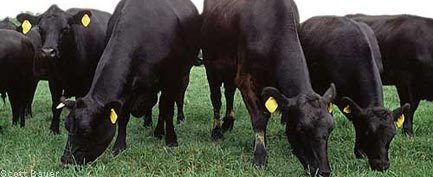Renewed Call to Get Antibiotics Out of Food

The use of the powerful antibiotic streptomycin as a growth-promoting agent in turkeys also quickly promotes the growth of dangerous streptomycin-resistant coliform bacteria, according to researchers at University of California, Davis.
Perhaps such a finding should be cause for alarm, considering how agribusiness pumps more than 20 million pound of antibiotics into healthy livestock each year, constituting more than 70 percent of all antibiotics used in the United States.
Then again, the aforementioned study was published in 1951. Hundreds of similar studies have since been published. But no one seems to care.
Yet as serious questions arise about U.S. food safety nearly monthly, and with antibiotic abuse rampant and with antibacterial-resistant "super bugs" reaching epidemic proportions, maybe it's time to rethink the practice of industrial-scale animal production.
Scientists at Johns Hopkins Bloomberg School of Public Health in Baltimore and the Pew Charitable Trusts are now calling for a phase-out and eventual ban of antibacterial agents for nontherapeutic use in livestock. They have taken their cause to Washington this month with ads in the Metro subway system and elsewhere.
Old MacDonald had some drugs
Antibiotics down on the industrial farm serve two purposes. They make some animals, particularly chickens, grow faster. Chickens raised the old-fashioned way mature in about 90 days; industrial farms raise them in 42 days with antibiotics and growth hormones.
Sign up for the Live Science daily newsletter now
Get the world’s most fascinating discoveries delivered straight to your inbox.
Antibiotics also help control the spread of harmful bacteria that is inevitable whenever you cram hundreds to tens of thousands of animals and their waste into cages only slightly bigger than their bodies.
Most antibiotics are given to healthy animals in low doses as a mass prophylaxis, a violation of the basic principle of antibiotic use. Antibiotics are intended for sick humans and animals and must be given at specific doses for a specific duration or else the bacteria they are killing can develop a resistance to the drug.
In his Nobel Prize acceptance speech, Alexander Fleming, the discoverer of penicillin, warned that antibacterial-resistant strains would develop simply by exposing bacteria to doses insufficient to kill all of them. This is exactly what agribusiness has done with millions of pounds of penicillin (now largely ineffective against many of the bacteria it once killed) and other antibiotics.
Evidence still lacking
The meat industry is correct, however, when it states that there is no firm evidence that its 60-year-old method of doing business is driving the trend of antibiotic resistance in bacteria sickening humans.
Yes, antibiotic-resistance costs the U.S. health care system $4 billion to $5 billion per year. Yes, the actual amount of antibiotics used by agribusiness is unknown for lack of regulation.
Yes, if you sample a manure lagoon, a typical feature on industrial farms, you will find antibiotic-resistant strains of all kinds of nasty bugs. Yes, flies could transmit that manure to hard surfaces, bodies or food miles away. Yes, studies have shown upwards of 98 percent of bacteria such as staph and streptococci sampled from the air in hog farms were resistant to two or more antibiotics. Yes, factory farm workers have high rates of asthma, and residents in surrounding communities have high rates of undiagnosed illnesses.
Yes, nearly 100 percent of residents in communities around chicken and hog farms have antibiotic-resistant bacteria in their guts that came from those farms.
But no, you cannot yet conclude, for example, that hospitals are filthy with multidrug-resistant staph (MRSA) because chicken, pork and beef conglomerates are using and abusing antibiotic x, y and z.
Agro-industrial complex
The meat industry argues that its practices have made food more affordable and that reducing antibiotic use will lead to more outbreaks of E. coli, salmonella and the like. The former is true at the cost of animal abuse and meat quality. The latter is perhaps true only because of the stressed, cramped conditions that breed bacteria.
The Pew Charitable Trusts reported serious obstacles to its study. Industry representatives were openly hostile, the report said, and threatened authors that they would withhold research funding at their universities. So it's unlikely the Pew commission can make an impact.
As the report noted, just as Dwight Eisenhower warned about the dangers of the military-industrial complex, we are faced with an "agro-industrial complex — an alliance of agriculture commodity groups, scientists at academic institutions who are paid by the industry, and their friends on Capitol Hill."
Mushrooms and tofu aren't that bad on the grill, you know.
Christopher Wanjek is the author of the books "Bad Medicine" and "Food At Work." His column, Bad Medicine, appears each Tuesday on LiveScience.

Christopher Wanjek is a Live Science contributor and a health and science writer. He is the author of three science books: Spacefarers (2020), Food at Work (2005) and Bad Medicine (2003). His "Food at Work" book and project, concerning workers' health, safety and productivity, was commissioned by the U.N.'s International Labor Organization. For Live Science, Christopher covers public health, nutrition and biology, and he has written extensively for The Washington Post and Sky & Telescope among others, as well as for the NASA Goddard Space Flight Center, where he was a senior writer. Christopher holds a Master of Health degree from Harvard School of Public Health and a degree in journalism from Temple University.
Flu: Facts about seasonal influenza and bird flu
What is hantavirus? The rare but deadly respiratory illness spread by rodents










